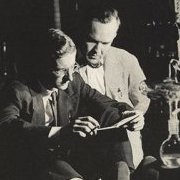-
Posts
4586 -
Joined
-
Last visited
-
Days Won
12
Content Type
Profiles
Forums
Events
Everything posted by hypervalent_iodine
-

Staring at naked women makes you smarter: Study
hypervalent_iodine replied to mooeypoo's topic in Science News
Such a good friend, moo; I know you'll always be there for me to rub away my problems. -

Staring at naked women makes you smarter: Study
hypervalent_iodine replied to mooeypoo's topic in Science News
I'm going to give you the benefit of the doubt here and assume you mean only to be triple blinded to protect yourself from the other two. -

Staring at naked women makes you smarter: Study
hypervalent_iodine replied to mooeypoo's topic in Science News
I think the mystery of which photo is which will become glaringly apparent by the responses of the first couple of participants. No amount of informed consent can prepare a person for a candid Phi shot. Or so I'm told. -
Well, that's embarrassing. I had my definitions a tad muddled. Geometric isomers fall under that definition, so you were right to include them. Alright, so now we have: (M) configuration of the biphenyl, (S) configuration at the stereocentre, cis double bond (M) configuration of the biphenyl, (S) configuration at the stereocentre, trans double bond (M) configuration of the biphenyl, (R) configuration at the stereocentre, cis double bond (M) configuration of the biphenyl, (R) configuration at the stereocentre, trans double bond (P) configuration of the biphenyl, (S) configuration at the stereocentre, cis double bond (P) configuration of the biphenyl, (S) configuration at the stereocentre, trans double bond (P) configuration of the biphenyl, (R) configuration at the stereocentre, cis double bond (P) configuration of the biphenyl, (R) configuration at the stereocentre, trans double bond Giving a total of 8.
-
You said the question asked you for stereoisomers, didn't you? Geometric isomers - i.e. cis and trans isomers - do not fall under this definition and would therefore not be counted in your answer if this is the case.
-

Confused about organic question
hypervalent_iodine replied to azazel2113's topic in Organic Chemistry
You know it's bad when you wake up in the morning and the first sinking feeling you think is, 'Ah, crap, I forgot an arrow and why the hell did I post that at 2.23am'? Welcome back, Horza. Anyway, I have no idea what you're talking about, if you'll see, my mechanism is totally correct and I absolutely did not go and fix it and edit my post accordingly. -
That's alright! Have a look at the link Horza posted if you haven't already. We've given Jessica a bit of help in there, so you can post any other questions you have in her thread. Hope you both got or are getting some sleep before the exam.
-

Confused about organic question
hypervalent_iodine replied to azazel2113's topic in Organic Chemistry
Alright, sunshine, we get it and we were just poking fun. I happen to agree with you, I just missed it when going through and getting pictures. Anyway, problem solved and I'm sure the OP understands that there is an arrow in there that wasn't drawn in by the author. But heck, for the sake of accuracy: I even included the partial charges; just for you, Horza. Can't have you being any more disappointed in me, now can we? -
The last sentence of your post was a bit convoluted, so I went to the trouble of clarifying it for Jessica. In any case, no need to get so territorial, dear; we're all friends here.
-
If you do that, you won't have methionine anymore. Presumably you bought methionine instead of isoleucine because you actually want methionine, yes?
-
Perhaps try typing in 'fuel isomerisation' instead, eh? Seriously though, we're not here to do your assignment for you. Do you have any ideas you want opinions on or any specific questions related to the topic?
-

Confused about organic question
hypervalent_iodine replied to azazel2113's topic in Organic Chemistry
I reckon I'll go back to my policy of drawing them all myself. And yes, damn Horza and his pedantic mechanism drawing -
I think that may be a typo. The product from the OsO4 reaction is definitely going to be a diol, not a dione. The reactions you have drawn there are fine. If the product for your last reaction is meant to be a dione, I suspect that your prof. may have accidentally called it E, when he/she meant to call it F.
-
Identical university and apparently identical answers.
-
Alright, well saying that there are two due to cis/trans isomerism is not correct. I'm not sure if you know how to properly assign configuration of biphenyls, so I'll give a quick overview just in case. Consider the following system: To assign the configuration of a chiral biphenyl system you need to do the following: Consider the positions of the substituents by looking down the single bond Draw a Fischer-type projection as follows: To assign priorities, near bonds (the NO2 and the CO2H in this case) come first. Assign them as per CIP priorities and then assign the far groups. You can assign (R) and (S) configuration that way. There are also (P) (plus) and (M) (minus) configurations, which are used specifically for biphenyls. In this, you view the compound as a helices and consider direction going from the first priority group to the third, as in the above diagram Are the groups you mentioned in any particular position, or were you just given the substituents and asked to figure it out? Assuming you know the position of the groups, you will have two possible stereoisomers, which arise from the chirality of the biphenyl system. The other thing to consider is that you have a substituent with a chiral centre, which means you now have a few possible combinations: (M) configuration of the biphenyl and (S) configuration at the stereocentre (M) configuration of the biphenyl and (R) configuration at the stereocentre (P) configuration of the biphenyl and (S) configuration at the stereocentre (P) configuration of the biphenyl and (R) configuration at the stereocentre So your answer of 4 is correct, though not for the reasons you've stated.
-

Confused about organic question
hypervalent_iodine replied to azazel2113's topic in Organic Chemistry
That's what I get for not really looking at the picture, I guess. It's implicit -
Your use of peracetic acid in the second one is quite odd. On a lab scale, you would usually use m-CPBA or just plain old H2O2. Not saying it won't work, it's just not often what you would encounter in a lab. I couldn't make out the last one, but all of the others seem okay.
-
Your compound G is drawn incorrectly. I don't see H being any different to D, really. Maybe ask your prof. if it's meant to be different?
-
Alright, so first things first. With your C4H6 compound - do you know how to calculate double bond equivalents yet? This will give you a huge hint with what sort of compound you're probably looking at if you can work out the DBE. Even if you don't, if you draw a straight chain or branched chain butyl chain, you should be able to work out if you need double or triple bonds and how many of them there will be (it will also tell you if you have a branched butyl chain in this case). Given that the addition of HCl in the next bit gives two products, you can also safely assume one of two options for your starting material, so you should be able to work out what you have as a starting material easily enough from that. Once you have that, it's a case of going through the reactions the question asks and deducing the product. Start by trying to work out what the starting material is first and we'll go from there. B and C as you've drawn them are exactly the same compound.
-
Yeah, but your reagents are a little whacky. As for the cyclohexene, you need to identify what kind of reaction it is and go from there.
-

Confused about organic question
hypervalent_iodine replied to azazel2113's topic in Organic Chemistry
Correct. Are you familiar with the mechanism for di-brominations with Br2? It is said to go via a cyclic bromonium ion intermediate, like this: (Image from here) Ignore the image I got from there and that was sitting right here where you're reading, as it's been deemed inaccurate. See this post for an updated mechanism. Which means that you will really only get 1,2-dibromination. I am slightly confused as to why the questions states it is a hydrobromination, though. There's clearly no proton source in your reaction, so that isn't going to happen (unless I'm missing something). -
Alright, so if you work backwards it might become a little more apparent what you have to do. Firstly, ask yourself what ways you know of to make 1,2-diols? From there, you'll have a starting material and it should be fairly apparent how to get that from your bromo-compound.
-
Stereoisomers are not the same as geometric isomers, so which one is it? If it is stereoisomers, then do you understand how biphenyl systems may possess chirality?
-
Is this a homework question? If so, you will need to tel lus what your thoughts are and what has you puzzled with the question. Do you know what a geometric isomer is?
-

Synthesis Route for Diol to Oxalane
hypervalent_iodine replied to dkhoo's topic in Organic Chemistry
If you know the mechanism, it should be fairly apparent what you're missing to drive the reaction. Hint: the addition of this is not needed for hemiacetal formation, but it is required for acetals.

